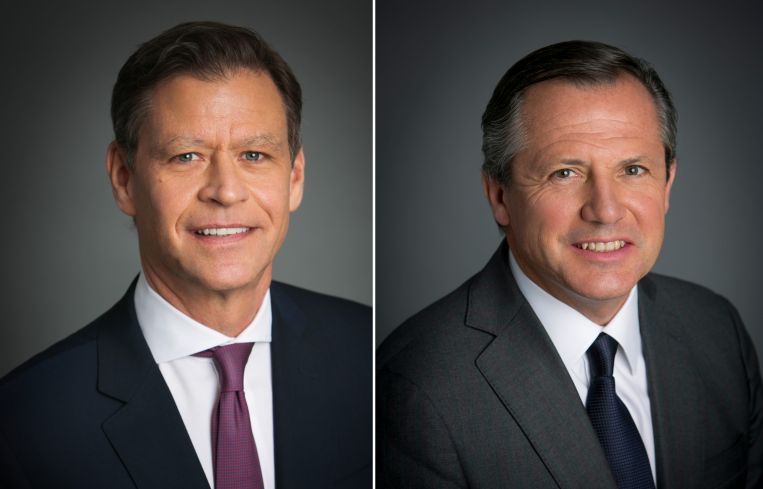Ric Clark and Kevin Danehy On the Potential of Digital Twinning
The pair from Brookfield Properties reunite through proptech firm Willow, which creates data-heavy virtual counterparts to the built environment
By Philip Russo October 5, 2021 9:00 am
reprints
Ric Clark and Kevin Danehy have known each other for three decades as friends and colleagues in commercial real estate, most recently together at Brookfield Properties, where Clark was chairman and Danehy was global head of development.
In the last year, each has embarked on new career pursuits. Those pursuits, though, have brought them together again. Clark, now managing partner at WatermanCLARK, is a major investor in Willow — a Sydney-based company specializing in what’s called digital twin technology, or creating virtual counterparts to physical assets or processes. Danehy is CEO North America at Willow.
Proptech Insider spoke with Clark and Danehy last week about their shared vision of technology’s fast-growing impact on real estate.
The interview has been edited for length and clarity.
PropTech Insider: Ric and Kevin, why did you make the transition from your respective long-time and high-level executive positions in corporate real estate to your current roles?
Ric Clark: I am an investor in Willow, but I’m not affiliated with the firm other than through my investment. I left Brookfield after a very long career to start a new, much smaller, more locally focused private commercial real estate private equity firm. Also, I have been personally investing in technology and innovation to help enhance real estate, something that I was always very passionate about since I was at Brookfield.
Kevin Danehy: Ric and I have known each other for close to 30 years, and, for nearly 10 years at Brookfield, I was working directly with Ric in a corporate development role. When Ric decided to make his pivot last year, he gave me an opportunity to take a look at what I was involved with and what the next chapter for me might look like.
One of the opportunities that I was most excited about while I was at Brookfield was seeing how real estate technology is being deployed across the real estate industry and commercial real estate assets, but more broadly across multiple asset categories, and how it is really changing the way that value could be recognized and created across the world.
One of the companies that I had spent quite a significant amount of time with over the last three or four years while I was helping to pilot phase-one engagement of office buildings Brookfield owns was Willow.
The Willow product is a digital twin, but by definition it’s really a two-technology integration platform that allows for many technology systems that are otherwise now used in asset management and operations in office buildings. They integrate with the digital twin and allow that to be an enormous aggregation of data that historically has not taken place. With that aggregation of data, we’re using applied science to make smart decisions about how to manage the asset, how to create additional value and how to improve margins. It’s a real difference maker.
Kevin, what Brookfield property were you working on using Willow?
Danehy: One Manhattan West, the 2 million-square-foot building just west of Madison Square Garden and Moynihan Station. The larger project is a building that had been under development design and construction for five or six years. The deployment of the digital twin allowed for the compilation of all the architectural, engineering and equipment information, and went into development of the property and the handover of the exact replica of One Manhattan West to the operations and asset management group.
Clark: One Manhattan West was the first one where Brookfield implemented Willow and is part of a 7 million-square-foot, mixed-use development. It’s about 6 million square feet of office space, another million square of multifamily, hotel and retail.
I’d add that if you’re in a senior leadership role, looking after any kind of physical asset, using technology and innovation to help achieve your goals and to give you a competitive edge is critical. This is something that Kevin, when we were working together at Brookfield, we were always looking for. Willow is an exciting company and technology that will help achieve those goals.
In an industry slow to change, when was it that you each thought you wanted to focus more on technology in real estate?
Clark: Probably when Kevin and I first started working together 10 years ago, it just dawned on me. Brookfield was one of the largest global real estate companies invested in virtually all sectors of real estate around the world and I just kept thinking, there’s just all this information that is available.
I looked at the way that the industry was operating and it was to me in a somewhat backward fashion. Take our commercial office buildings for example. We were always sort of forcing our users to adapt to the building’s capabilities versus doing the opposite, trying to figure out how a tenant actually used the building and adapting the building to help facilitate the tenants achieve their goals. Kevin and I started to work together to be able to aggregate the data that we needed to make important decisions and we were looking for tools to help us do that.
Danehy: The industry also came together. One of the things that Ric encouraged me to do was to talk with some of Brookfield’s major traditional competitors, about how the industry was dealing with technology and how to aggregate data at scale. About four years ago, a group of like-minded owner operators, including Oxford, Blackstone, Hines, Durst, RXR and some others, agreed to [continue to] compete fiercely for a product and for capital, but when it came to technology, realized that things are changing faster than any one of the individual firms or the people within it were able to get our arms and our heads around. So we began to see how technology might be better harnessed.
About that time, one of the things that was beginning to become evident was the point solutions that had developed in the proptech arena — like VTS for leasing and Honest Buildings, which was acquired by Procore, for capital project management. It became clear to us that of the dozen or so separate functions that a real estate organization needs to do to be a great owner-operator — leasing, capital project management, development, etc. — were beginning to be supported by a technology platform.
And what did that yield?
Danehy: Number one, efficiency was brought to the function. VTS in leasing, for example. But, also of even greater significance, the process was captured with data from beginning to end. Again, using leasing as the example, from the first inquiry from the tenant themselves or from the broker all the way through to when the lease was completed and entered into the rent roll of the owner’s asset management system, a complete record is maintained.
While we’re looking at these support solutions, we also explored what the big tech firms were doing. We developed a strong relationship with Microsoft, who in our opinion, is years ahead of where the other large technology companies are in large part because they’ve been rebuilding their own campus in Redmond [Wash.] in the last four years. They’ve knocked down 9.4 million square feet of their 15 million-square-foot campus and rebuilt office buildings for technology infrastructure.
As they’ve been doing that they’ve been looking for best in class, new emerging proptech category leaders, and Willow is one of them that Microsoft has embraced for their own portfolio as well as to help Willow become stronger and faster in global deployment and scalability.
Ric, you are now running a real estate private equity firm, but you are investing as well. What has changed for you in your daily work that you didn’t expect?
Clark: I had been with Brookfield and its predecessor company for over 30 years and I was ready to pass on the reins to the next generation. But also I wanted to do something more entrepreneurial. So, I started a new private equity firm with a longtime friend and business partner, Tod Waterman, called Waterman Clark.
Principally, that’s what I’m doing. I’m running a small locally focused real estate business, but also making investments in innovation and technology that helps support real estate because I’m a big believer in the impact that innovation and technology have on real estate performance.
Of course, anything that I find throughout my dealings in my business day that I think will dramatically help my business perform better is something that I believe I should be investing in. So I’m making those kinds of investments.
Danehy: I really give Ric credit as being one of the pioneers in what Brookfield brands as placemaking, but the world wildly identifies as creating commercial campuses in global gateway cities where there’s a co-location of high-rise office buildings, multifamily, retail and and hotels. He has been doing that for close to 20 years now and really led the global adoption of placemaking as a practice as opposed to just a buzzword.
What Ric is talking about now is going to the next phase of his career and his forward-thinking is to digitize the built world and use technology to enhance the value of these assets. Along with Ric, two of the other major investors in Willow are Nicholas Moore, CEO of Macquarie Bank for 13 years, and Jim Cooney [non-executive director, Willow Chairman, TCI Renewables], who’s our largest single investor. The three of them each individually created among the largest global portfolios of physical assets ever amassed in infrastructure and real estate.
It’s actually quite remarkable that the three of them have come together now in a kind of a second phase or second act of their careers, to invest, not only their reputations, but also their money, and providing advice and support for technology deployment across infrastructure and commercial real estate assets so that additional value is created and that the world’s a better place to live.
Clark: I first met [Moore] many years ago in Sydney, Australia, when he led Macquarie Bank. Brookfield built his building in Sydney. It was very technologically forward, very innovative and it was the first time I was exposed to a building that was completely an open-space plan. Nick is a very forward thinking executive, so it’s a pleasure to be invested in a company in which he is so involved.
What is it about Willow’s version of twinning that you consider a differentiator? And why is twinning becoming such an important part of real estate?
Danehy: The strong endorsement by Nick Moore, but also the executive leadership at Microsoft. A couple of the executives at Microsoft who have been intimately involved for well over the last three or four years have been Sam George and Bert Van Hoof. They’re responsible for the growth and deployment of the Azure cloud platform. The strength of their conviction in Willow as a category leader and the fact that they’ve got a commanding lead in the business, even though there are many other large companies that are seeking to create digital twins as well, was really important.
Among the three most important elements, number one is being committed to a totally open source approach to [Willow’s] deployment, so that it can end up serving as a digital platform through which all these other technology systems involved in running a building, whether it’s accounting, BMS, leasing, security or anything in between, can be mixed and matched across other buildings, with everyone having a unique combination of different technology platforms and versions that are existing within it.
Number two, the rollover strategy was to start with large global leaders like Walmart, Brookfield and JPMorgan Chase, and create full fidelity twins, which are exact 3-D representations. For instance, One Manhattan West has 5,000 different data points.
Third is that the twin and this technology is designed to be used by the person responsible for running the asset, engineers, asset managers and leasing agents. The people who don’t have a lot of time to spend time being educated on how a technology system works, but rather are able to use it because it’s very intuitive and designed for people to use as opposed to needing significant education.
Bottom line, what’s the value add of digital twinning?
The real opportunity is to combine the outputs from multiple technology systems: The combination of how sensors, occupancy data, heating and air conditioning, and power consumption can be integrated, actually showing how less energy is being consumed, is a huge step.
Of even more significance is as we shift from fossil fuel-based power being supplied to the database and use blockchain and other means to track the source of the power generation from a hydro plant or some other renewable energy source to the building, the asset will create the opportunity for employers and owners who are making sustainability commitments — carbon neutrality commitments — to actually have an immutable blockchain audit trail that allows them to measure how they’re actually achieving those results.
That is important for investors in today’s climate, for shareholders, employees and customers all to know that these sustainability commitments are not just greenwashing, but that they’re actually a quantifiable way being measured and achieved. The digital twin allows for that to be accomplished in a very straightforward, cost-effective way.
Philip Russo can be reached at prusso@commercialobserver.com.


